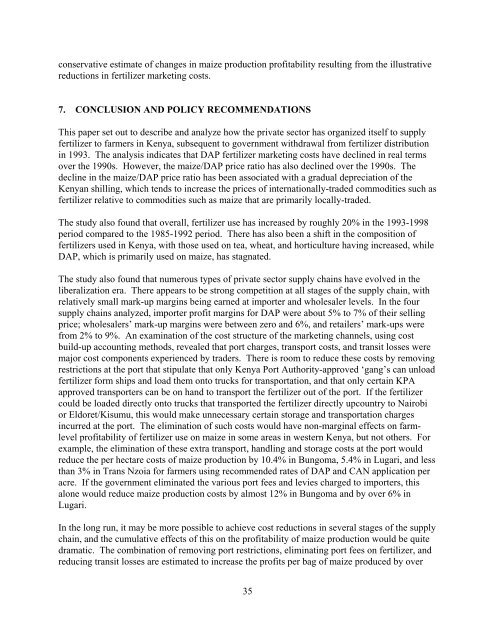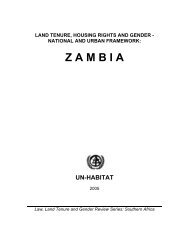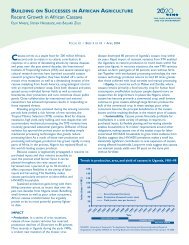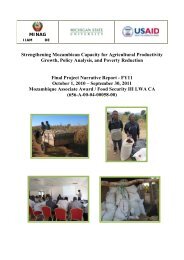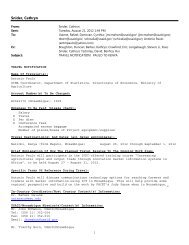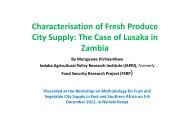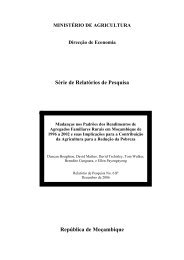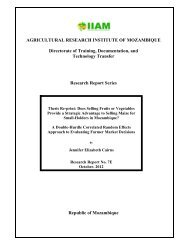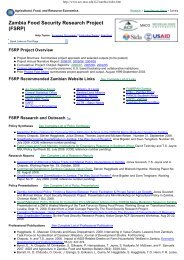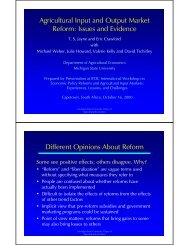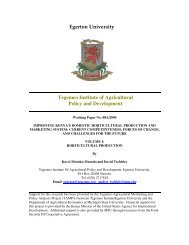Fertilizer Markets and Agricultural Production Incentives - Tegemeo ...
Fertilizer Markets and Agricultural Production Incentives - Tegemeo ...
Fertilizer Markets and Agricultural Production Incentives - Tegemeo ...
Create successful ePaper yourself
Turn your PDF publications into a flip-book with our unique Google optimized e-Paper software.
conservative estimate of changes in maize production profitability resulting from the illustrative<br />
reductions in fertilizer marketing costs.<br />
7. CONCLUSION AND POLICY RECOMMENDATIONS<br />
This paper set out to describe <strong>and</strong> analyze how the private sector has organized itself to supply<br />
fertilizer to farmers in Kenya, subsequent to government withdrawal from fertilizer distribution<br />
in 1993. The analysis indicates that DAP fertilizer marketing costs have declined in real terms<br />
over the 1990s. However, the maize/DAP price ratio has also declined over the 1990s. The<br />
decline in the maize/DAP price ratio has been associated with a gradual depreciation of the<br />
Kenyan shilling, which tends to increase the prices of internationally-traded commodities such as<br />
fertilizer relative to commodities such as maize that are primarily locally-traded.<br />
The study also found that overall, fertilizer use has increased by roughly 20% in the 1993-1998<br />
period compared to the 1985-1992 period. There has also been a shift in the composition of<br />
fertilizers used in Kenya, with those used on tea, wheat, <strong>and</strong> horticulture having increased, while<br />
DAP, which is primarily used on maize, has stagnated.<br />
The study also found that numerous types of private sector supply chains have evolved in the<br />
liberalization era. There appears to be strong competition at all stages of the supply chain, with<br />
relatively small mark-up margins being earned at importer <strong>and</strong> wholesaler levels. In the four<br />
supply chains analyzed, importer profit margins for DAP were about 5% to 7% of their selling<br />
price; wholesalers’ mark-up margins were between zero <strong>and</strong> 6%, <strong>and</strong> retailers’ mark-ups were<br />
from 2% to 9%. An examination of the cost structure of the marketing channels, using cost<br />
build-up accounting methods, revealed that port charges, transport costs, <strong>and</strong> transit losses were<br />
major cost components experienced by traders. There is room to reduce these costs by removing<br />
restrictions at the port that stipulate that only Kenya Port Authority-approved ‘gang’s can unload<br />
fertilizer form ships <strong>and</strong> load them onto trucks for transportation, <strong>and</strong> that only certain KPA<br />
approved transporters can be on h<strong>and</strong> to transport the fertilizer out of the port. If the fertilizer<br />
could be loaded directly onto trucks that transported the fertilizer directly upcountry to Nairobi<br />
or Eldoret/Kisumu, this would make unnecessary certain storage <strong>and</strong> transportation charges<br />
incurred at the port. The elimination of such costs would have non-marginal effects on farmlevel<br />
profitability of fertilizer use on maize in some areas in western Kenya, but not others. For<br />
example, the elimination of these extra transport, h<strong>and</strong>ling <strong>and</strong> storage costs at the port would<br />
reduce the per hectare costs of maize production by 10.4% in Bungoma, 5.4% in Lugari, <strong>and</strong> less<br />
than 3% in Trans Nzoia for farmers using recommended rates of DAP <strong>and</strong> CAN application per<br />
acre. If the government eliminated the various port fees <strong>and</strong> levies charged to importers, this<br />
alone would reduce maize production costs by almost 12% in Bungoma <strong>and</strong> by over 6% in<br />
Lugari.<br />
In the long run, it may be more possible to achieve cost reductions in several stages of the supply<br />
chain, <strong>and</strong> the cumulative effects of this on the profitability of maize production would be quite<br />
dramatic. The combination of removing port restrictions, eliminating port fees on fertilizer, <strong>and</strong><br />
reducing transit losses are estimated to increase the profits per bag of maize produced by over<br />
35


